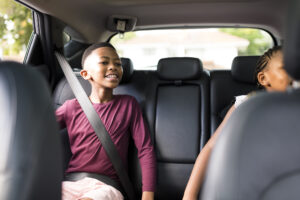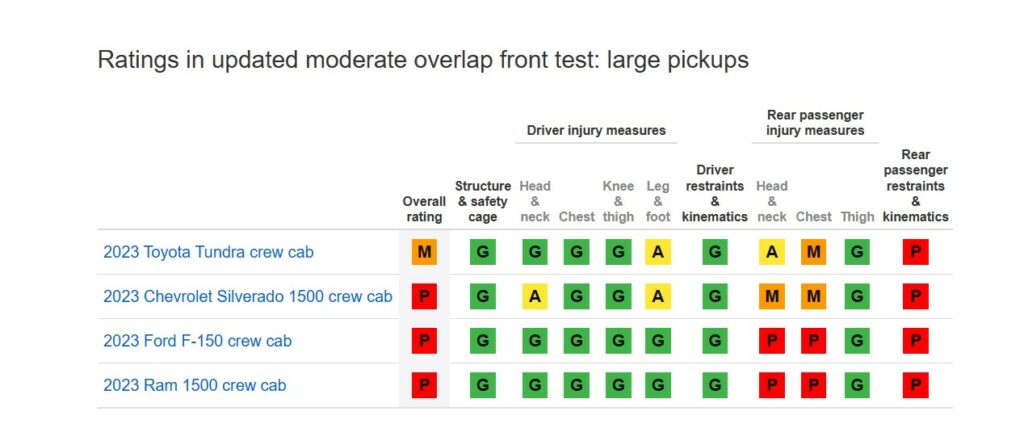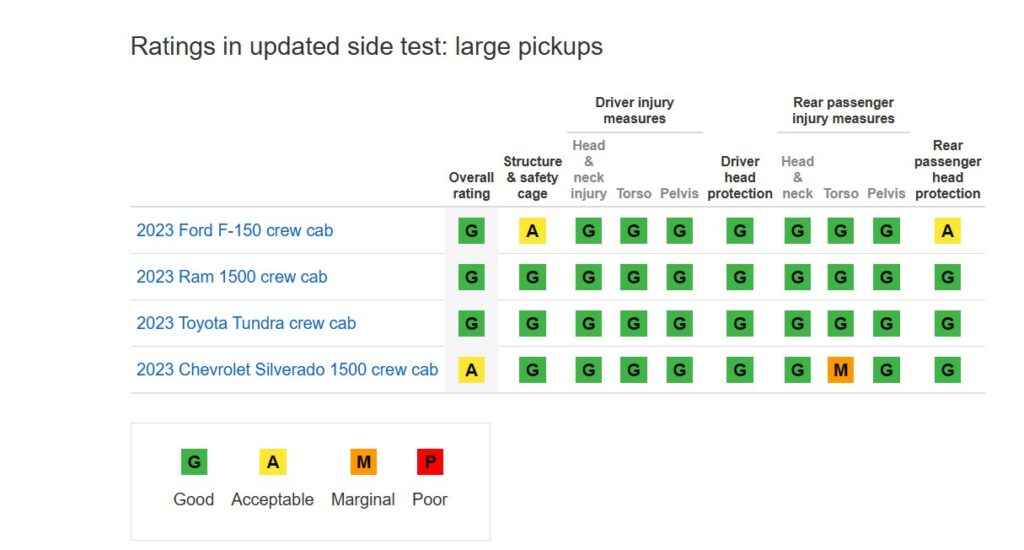
IIHS safety tests 4 pickups, all fail to protect backseat passengers
By onCollision Repair | Market Trends
The Insurance Institute for Highway Safety (IIHS) says it performed its updated moderate overlap safety test on four large pickups, and none received a favorable rating.
However, all of the 2023 crew cab vehicles — including the RAM 1500, Ford F-150, Toyota Tundra, and Chevrolet Silverado 1500 — offered strong protection during side crashes.
IIHS launched its updated moderate overlap front test last year after research indicated that in newer models, the risk of a deadly injury is higher for those in the second row than it is in the front. The test emphasizes backseat safety.
Until relatively recently, backseat passengers were less likely to die in a crash because of vehicle design. However, many automakers are now adding advanced seat belts and air bags in the front row but not usually in the back, making the backseat a more dangerous place to be for those traveling in 2007 or newer models, IIHS said.
A recent IIHS study of real-world crashes showed that in many cases, backseat passengers were injured more severely than front seat occupants.
When performing its updated moderate overlap safety test on the pickups, IIHS said the Tundra was the only vehicle to receive a marginal rating. The other three were rated poor.
“Like most other vehicle classes, large pickups don’t perform as well in the new moderate overlap evaluation as they do in the updated side test, which is now a requirement for our Top Safety Pick awards,” said David Harkey, IIHS president.

In the updated test, a second dummy the size of a 12-year-old child is positioned in the back row behind the driver, IIHS said. It added that its researchers developed new metrics that focus on the injuries most frequently seen in backseat passengers.
In order for a vehicle to receive a good rating, there must not be excessive risk of injury to the head, neck, chest, or thigh, as recorded by the second-row dummy, IIHS said. It noted that the dummy should remain correctly positioned during the crash without sliding forward beneath the seat belt, also known as “submarining,” which increases the risk of abdominal injuries.
Other requirements are that the head remains a safe distance from the vehicle interior and that the seat belt remains on the shoulder. During the test, there is a pressure sensor on the dummy’s torso to determine whether the shoulder belt stayed in the correct position, IIHS said.
As in the original test, there must also be enough occupant compartment space for the driver to remain safe and measurements taken from the driver dummy should not show an excessive risk of injury, according to IIHS.

The results showed that while all of the pickups provided good protection in the front seat, the backseat restraint systems weren’t acceptable.
“Submarining was a problem for all four pickups, and belt forces were too high in all but the Tundra,” Harkey said.
On the F-150 and Ram 1500, IIHS said measurements indicated that chest injuries and head or neck injuries were likely. The risk of injuries in the Silverado was lower but still excessive, IIHS said.
RAM advises “Following any collision inspect the seat belts for proper function and operation prior to returning the vehicle to the customer”.
Its repair guidance for driver and passenger positions includes inspecting the:
- Seat belt for fraying, cuts, fading, and torn or loose stitching;
- Seat buckles for proper latching and releasing operation;
- Seat belt retractor by slowly extending the seat belt fully and ensuring it extends smoothly without binding or locking. Also, ensure the seat belt locks by latching it and then pulling the belt quickly;
- Seat belt turning loop, which should move freely and lock firmly into the different height positions; and
- Seat belt turning loop height adjuster, which should move freely and lock firmly into different height positions.
For the Tundra, Toyota advises repairers to first perform a diagnostic check when inspecting the rear belt outer assembly for vehicles involved in a collision. Repair technicians can refer to the GTS operator’s manual for further details, it said.
In fact, Toyota has procedures to “INSPECT REAR SEAT OUTER BELT ASSEMBLY” for both “Vehicle not Involved in Collision” and “Vehicle Involved in Collision.” Both involve a “diagnostic system check” and visual checks for:
- Cuts on the rear seat outer belt assembly;
- Small cracks on the rear seat outer belt assembly; and
- Significant discoloration on the rear seat outer belt assembly.
In event of a collision, repair technicians should also check for cracks or other damage to the connector, it said.
Ford’s documentation on the 2023 F-150 Seatbelt System Functional Tests comes with a visual, bolded warning.
“WARNING: All seatbelt components must be inspected and corrected as part of any collision repair. Inspect all seatbelt components as prescribed by Seatbelt Procedure After a Collision found in Section 501-20A General Procedures of this manual. Failure to follow this instruction may result in incorrect operation of the seatbelt system and increase the risk of serious personal injury or death in a crash.”
Ford’s documentation on the 2023 F-150 Seatbelt System Functional Tests comes with a visual, bolded warning.
“WARNING: All seatbelt components must be inspected and corrected as part of any collision repair,” it says. “Inspect all seatbelt components as prescribed by Seatbelt Procedure After a Collision found in Section 501-20A General Procedures of this manual. Failure to follow this instruction may result in incorrect operation of the seatbelt system and increase the risk of serious personal injury or death in a crash.”
General Motors (GM) said that as restraint systems can be damaged in a collision, the Chevrolet Silverado’s seat belt systems should be replaced in cases where collisions were serious enough to deploy automatic restraint devices and seat belt pre-tensioners.
This includes seat belt systems used by adults as well as systems used to latch child car seats, it said. GM added that any seat belt system that is worn, torn or has damaged components should be replaced.
GM also said that belt systems should be replaced if repairers see the words “replace, “caution,” or if a yellow tag is showing. However, it said a seat belt should not be replaced if only the child seat caution label is visible.
If a repairer is doubtful about a seat belt’s condition, it should be replaced, GM said.
GM’s guidance is to not replace single-seat belt system components in heavily collision-damaged vehicles and to instead replace the entire system with the buckle, guide, and retractor assembly including the latch and webbing material.
In minor collisions where automatic restraint devices were not deployed, GM said replacing the seat belt system might not be necessary unless there are signs of wear, tear, or damage.
IIHS previously performed its updated moderate overlap safety test on minivans, with none of them scoring well.
Images
Featured image courtesy of PixelCatchers/iStock
Secondary graphs courtesy of IIHS
